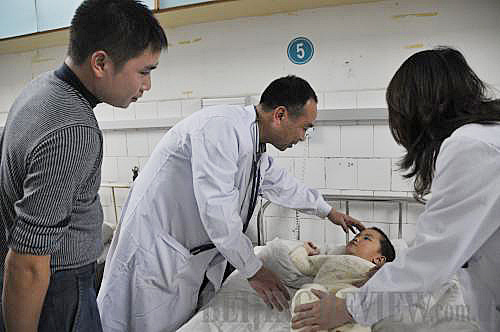|
 |
|
METAL HURTS: A child, diagnosed as having excessive levels of lead in his blood, receives treatment at a hospital in Chenzhou, central China's Hunan Province, on March 20, 2010 (MING XING) |
Rich in mineral resources, Hunan Province in central China is known as "the land of nonferrous metals." But in recent years, a series of lead poisoning cases and a recent report on "cadmium-tainted rice" have put heavy metal pollution there under the spotlight.
In 2010, more than 200 children in Chenzhou City were found with excessive lead levels in their blood due to pollution from the local mining industry. In 2009, more than 1,350 children in Wenping Township, Wugang City, were also diagnosed with the same problem due to pollution from a local smelting plant.
In 2006, cadmium contamination sickened 150 villagers in Zhuzhou's Xinma Village and caused two deaths. Residents finally learned two samples of locally-grown rice used for laboratory tests contained 2.5 times the safe amounts of cadmium.
A string of heavy metal poisoning cases have also been reported in Shaanxi, Anhui, Guangdong, Sichuan, Fujian and Yunnan provinces and Guangxi Zhuang Autonomous Region.
An earlier sample study conducted by the Ministry of Environmental Protection found 36,000 hectares of 300,000 hectares of farmland tested were polluted with heavy metal. Another assessment showed up to 12 million tons of food is contaminated by heavy metal each year, creating a direct economic loss of 20 billion yuan ($2.93 billion).
Cadmium-tainted rice
In February, Beijing-based Century Weekly magazine reported a survey made by Nanjing Agricultural University in 2007 found 10 percent of rice samples collected from markets contain excessive levels of cadmium.
Cadmium is a silver-white substance easily absorbed by rice. Long-term exposure to cadmium could lead to calcium loss in bones and kidney failure, according to Zhou Zijun, a professor at the School of Public Health of Peking University.
The findings came after a research team, led by Pan Genxing, a professor at Nanjing Agricultural University's Institute of Resource, Ecosystem and Environment of Agriculture, tested samples of 91 varieties of rice collected from markets in six agricultural regions in China in 2007.
In April 2008, Pan led another research team to agricultural produce markets in Jiangxi, Hunan and Guangdong provinces, taking 63 samples. They found more than 60 percent of the rice samples were tainted with cadmium. In some samples, the cadmium levels are five times the legal maximum.
In fact, early in 2002, a nationwide rice testing by the Ministry of Agriculture showed 28.4 percent of surveyed rice was contaminated with lead, and 10.3 percent with cadmium.
China, which produces and consumes more rice than any other country, grows nearly 200 million tons of rice a year.
The Century Weekly report says dozens of residents in Sidi Village in southwest China's Guangxi, where cadmium pollution is heavy, are suspected of having the symptoms of itai-itai disease, which is characterized by pain in the joints and the spine.
The report cites statistics from the Guilin Institute of Technology showing the level of cadmium was 1.005 milligrams in every kg of locally-grown rice in 1986, five times the standard amount.
Sidi's situation is not particularly rare. Similar cases of itai-itai disease have been documented in other parts of China, including areas around the communities of Suichang and Wenzhou in eastern Zhejiang, where researchers found cadmium levels in rice paddies exceeding national limits by six times.
For a long time, the Xiangjiang River in Hunan has been known as one of China's most polluted waterways.
"In some sections of the river, the heavy metal levels exceed national limits by several hundred times," said Zhang Zhiguang, Director of the Division of Science and Technology of Hunan Provincial Environmental Protection Department. "You could just dredge the mud and process it in a refinery."
In Zhuzhou's Qingshuitang Industrial District, home to Zhuzhou Smelter Group Co. Ltd., the country's largest zinc and lead producer, the monitoring agency found the concentration of cadmium, mercury and lead in local vegetables is almost 65 times, 186 times and 66 times the national safety standard for their content in food, respectively.
In fact, Zhuzhou is just one location along the Xiangjiang River that suffers from heavy metal pollution. Running from south to north, the river drains 95,000 square km and supplies drinking water for at least 20 million people.
Due to developed nonferrous metals mining and smelting industries, the cities of Hengyang, Xiangtan and Chenzhou are three other victims of pollution from nonferrous mining operations along the Xiangjiang River.
Zeng Xibai, a professor at the Institute of Environment and Sustainable Development in Agriculture of the Chinese Academy of Agricultural Sciences, conducted a study and found heavy metal from mining areas and smelting plants poses a more serious threat to nearby farming areas. The heavy metal content in plants and soils there was at least 10 times higher than normal croplands.
| 